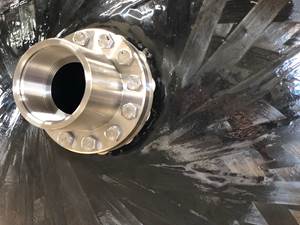American wind energy adds jobs in 2014, credits PTC tax credit
The industry calls on Congress to extend the Production Tax Credit (PTC) for wind power.
The U.S. wind industry added 23,000 jobs in 2014, boosting the sector’s total to 73,000 jobs. This year began with 12,700 MW of wind projects under construction, a record for the start of any year, according to the American Wind Energy Association (AWEA, Washington, DC, US) in its U.S. Wind Industry Annual Market Report.
Tom Kiernan, CEO of AWEA, said that the results show that extending the Production Tax Credit (PTC) for wind power in 2013 was good for business. There was four times more new wind power generating capacity online last year than in 2013. The 2013 wind deployment was down 92% from 2012 levels because of policy uncertainty caused by the brief lapse of the PTC at the end of 2012. That lapse resulted in the loss of 30,000 wind industry jobs in America.
The PTC expired in 2014 and the wind industry is asking Congress to revive it, however, a majority of the Senate went on record against a five-year extension of the PTC this past January. While President Obama’s proposed 2016 budget would permanently extend the PTC, it is unclear if Congress will approve it.
In the U.S. wind manufacturing sector specifically, wind now employs nearly 20,000 workers in more than 500 facilities across 43 states, in addition to 53,000 other jobs in project development, construction, operations, and other parts of the industry. The U.S. wind industry drove $12 billion in private investment last year, for a total of more than $100 billion since 2008.
“The PTC enabled the private sector to make critical investments in domestic manufacturing and the American workforce, driving significant cost reductions. That has driven technology improvements and cost reductions that are creating a modern day ‘wind rush’ by opening up new areas for development,” said AWEA Deputy Director of Industry Data and Analysis Emily Williams. “We have utility scale turbines operating in 39 states today, and if these trends continue and stable policy is in place, we can see wind deployment in even more states.”
A U.S. Department of Energy report released last month shows that wind energy can double within the next five years to supply 10 percent of U.S. electricity by 2020, 20 percent by 2030, and 35 percent by 2050.
Strong activity in Texas
The U.S. “wind rush” is at its height in Texas, with 7,500 MW of wind projects currently under construction, more than all other states combined. The wind industry invested $3 billion in Texas last year, bringing total cumulative investment to over $26 billion.
The completion of the Competitive Renewable Energy Zone (CREZ) transmission lines a year ago has played a critical role in opening up Texas’s wind resources to development. That success will soon be replicated in other parts of the Plains and the Midwest, which are following suit with major new transmission upgrades.
The Texas wind boom resulted in the addition of 9,000 jobs in 2014, bringing Texas to a U.S.leading 17,000 wind industry jobs. Rounding out the top five states with the most wind industry jobs are Iowa and Colorado with over 6,000 jobs each, Oklahoma with nearly 5,000 jobs, and Michigan with over 3,000 jobs.
Ohio again ranks number one in wind manufacturing facilities, while Colorado and then Iowa lead with the most manufacturing jobs.
Related Content
Revolutionizing space composites: A new era of satellite materials
A new approach for high volumes of small satellite structures uses low-CTE, low-cost CFRP cellular core, robust single-ply skins and modular panel systems to cut lead time, labor and cost for reflectors, solar arrays and more.
Read MoreAchieving composites innovation through collaboration
Stephen Heinz, vice president of R&I for Syensqo delivered an inspirational keynote at SAMPE 2024, highlighting the significant role of composite materials in emerging technologies and encouraging broader collaboration within the manufacturing community.
Read MoreWe4Ce infused 2.5-3-MW rotor blade design passes validation test
Composite rotor blade structure design by We4Ce, mold and prototype production by InDutch Composites and fatigue testing by Suzlon Group has resulted in the novel blade’s IEC61400-5:2020 certification.
Read MoreInfinite Composites: Type V tanks for space, hydrogen, automotive and more
After a decade of proving its linerless, weight-saving composite tanks with NASA and more than 30 aerospace companies, this CryoSphere pioneer is scaling for growth in commercial space and sustainable transportation on Earth.
Read MoreRead Next
Scaling up, optimizing the flax fiber composite camper
Greenlander’s Sherpa RV cab, which is largely constructed from flax fiber/bio-epoxy sandwich panels, nears commercial production readiness and next-generation scale-up.
Read MoreCeramic matrix composites: Faster, cheaper, higher temperature
New players proliferate, increasing CMC materials and manufacturing capacity, novel processes and automation to meet demand for higher part volumes and performance.
Read MoreUltrasonic welding for in-space manufacturing of CFRTP
Agile Ultrasonics and NASA trial robotic-compatible carbon fiber-reinforced thermoplastic ultrasonic welding technology for space structures.
Read More












